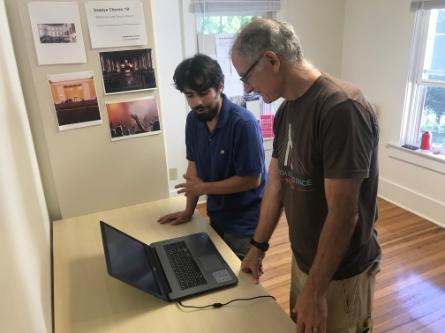
As a sophomore, I applied and was accepted to the Ammerman Center for Arts and Technology at Connecticut College. The Center is one of the five academic centers on campus that provides resources to students and faculty doing interdisciplinary work on a specific subject. Learn more about my journey as an Ammerman Scholar.
This semester I’m starting to produce my senior integrative project (SIP) for the Ammerman Center. SIPs are year-long independent study projects that seniors participating in the College’s four center-certificate programs undertake culminating in a final performance or installation from each senior every spring. My project is an attempt to develop a piece of classical music where audience members get to participate. It currently uses the working title “Democracy and Classical Music,” which stems from a challenge posed to me by professors who I have worked closely with developing this project. They posited that allowing audience members to interact raises problems similar to those raised by the challenge of satisfying people with different viewpoints in the democratic process.
As part of my process for my SIP, I’m enrolled in a seminar where we talk about and document our progress and present our projects during Fall Weekend. When choosing what aspect of my project to present I selected a near-complete program I developed to test the aleatoric (chance-based) pieces I composed for my project. The program is intended to randomly select files that sample my composition and produce a possible rendering of it. My idea was to use the program to generate new renderings of my composition during the presentation.
As often happens in coding, I had no idea just how hard it would be to get this program to work as intended. When I last worked on it a few weeks prior to Fall Weekend, I had developed it to a point that allowed me to randomly create an audio file for one part in a four-part texture. My goal for Fall Weekend was to develop a program that could combine the audio files for four generated parts into a single audio file. However, I quickly discovered that this task was more difficult than I anticipated: the functions I had for editing my audio used a format for data storage I’d never worked with before, and I also was having trouble determining how to set properties (such as sound quality) for the file.
I spent most of Thursday and Friday evenings learning to work around these issues. Finally, on Saturday morning, hours before the presentation, I was able to create a program that could generate a version of my composition with a lot of static distortion (it sounded like listening to a barely audible radio station). After trying to tweak the generated audio files’ properties a few times, I realized that producing a file featuring a four-part harmony with the resources at my disposal was impossible. I opened Adobe Audition (we have most of the Adobe suite on all school computers), an audio editing program, and in a few minutes, used some already randomized audio files to make five sample versions of the composition. Basically, I did a task in a couple of minutes that I’d struggled for hours to try to automate.
Despite having my presentation not go according to plan before it even started, talking with Fall Weekend visitors was an enlightening part of my process. I didn’t realize how interested people would be in elements of my project beyond the presentation of my current composition and its various renderings. But I soon found myself explaining and demonstrating some of the code I used in the programming languages PHP–to simulate uploading audience members’ choices, and Max msp–to simulate downloading audience members’ choices. Overall I had fun talking about my project and tech in general.